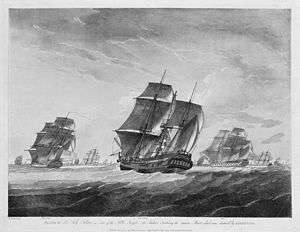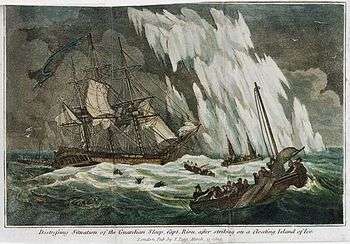Second Fleet (Australia)
The Second Fleet is the name of the second fleet of ships sent with settlers, convicts and supplies to colony at Sydney Cove in Port Jackson, Australia. The fleet comprised six ships: one Royal Navy escort, four convict ships, and a supply ship.
The ships were intended to sail to Australia together, arriving at Sydney Cove in 1789. However the escort was disabled en route and failed to make the destination, and one convict ship which was delayed arrived two months after the other ships.
Unlike the preceding First Fleet, where great efforts were taken to ensure the health of the convicts, the Second Fleet was contracted to private businesses who kept the convicts in horrific conditions. Upon arrival the sickly convicts were a drain on the already struggling colony.[1]
Fleet summary
| Ship | Image | Type | Master | Crew | Dep. England | Arr. Sydney | Duration | Male convicts arrived (boarded) | Female convicts arrived (boarded) |
|---|---|---|---|---|---|---|---|---|---|
| Lady Juliana |  |
convict transport | Thomas Edgar | 35 | 29 July 1789 | 3 June 1790 | 309 days | n/a | 222 (226) |
| Guardian |  |
converted gun ship to convict transport | Edward Riou | 12 September 1789 | disabled en route | n/a | 20 (25) - see below | n/a | |
| Justinian | storeship | 20 January 1790 | 20 June 1790 | 151 days | |||||
| Surprize | converted merchant ship to convict transport | Nicholas Anstis | 19 January 1790 | 26 June 1790 | 158 days | 218 (254) | n/a | ||
| Neptune |  |
convict transport | Donald Traill | 19 January 1790 | 27 June 1790 | 159 days | ? (421) + 12 from Guardian | ? (78) | |
| Scarborough | converted transport to convict ship | John Marshall | 19 January 1790 | 28 June 1790 | 160 days | 180 (253) + 8 from Guardian | n/a |
Origins and history
Lady Juliana sailed before the other convict ships and is not always counted as a member of the Second Fleet. The storeship Justinian did not sail with the convict ships and arrived before them. HMS Guardian set out before the convict ships but struck ice after leaving the Cape of Good Hope, returned to southern Africa, and was wrecked on the coast.
'Surprize, Neptune, and Scarborough were contracted from the firm Camden, Calvert & King, which undertook to transport, clothe and feed the convicts for a flat fee of £17 7s. 6d per head, whether they landed alive or not. This firm had previously been involved in transporting slaves to North America. The only agents of the Crown in the crew were the naval agent, Lieutenant John Shapcote, and the Captain of the Guard; Camden and Calvert supplied all other crew..
The three vessels left England on 19 January 1790, with 1,006 convicts (928 male and 78 female) on board. They made only one stop on the way, at the Cape of Good Hope. Here 20 male convicts, survivors from HMS Guardian, were taken on board. The three vessels made a faster trip than the First Fleet, arriving at Port Jackson in the last week of June 1790, three weeks after Lady Juliana, and one week after the storeship Justinian.
The passage was relatively fast, but the mortality rate was the highest in the history of transportation to Australia. Of the 1,026 convicts embarked, 267 (256 men and 11 women) died during the voyage (26%).
On Neptune the convicts were deliberately starved, kept chained, and frequently refused access to the deck. Scurvy could not be checked. On Scarborough, rations were not deliberately withheld, but a reported mutiny attempt led to the convicts being closely confined below decks.[2]
Captain William Hill, commander of the guard, afterwards wrote a strong criticism of the ships' masters stating that “the more they can withhold from the unhappy wretches the more provisions they have to dispose of at a foreign market, and the earlier in the voyage they die, the longer they can draw the deceased's allowance to themselves”.
Arrival at Port Jackson
On arrival at Port Jackson, half-naked convicts were lying without bedding, too ill to move. Those unable to walk were slung over the side. All were covered with lice. At least 486 sick were landed (47% of those embarked). Of these, 124 died shortly after they had landed. Of the rest the Rev. Johnson, who went among them as soon as the ships reached port, wrote:[3]
The misery I saw amongst them is indescribable ... their heads, bodies, clothes, blankets, were all full of lice. They were wretched, naked, filthy, dirty, lousy, and many of them utterly unable to stand, to creep, or even to stir hand or foot.
Governor Phillip noted [4]
I will not, sir, dwell on the scene of misery which the hospitals and sick tents exhibited when these people were landed, but it would be want of duty not to say that it was occasioned by the contractors having crowded too many on board these ships, and from their being too much confined during the passage.
Among the arrivals on the Second Fleet were D'Arcy Wentworth and his convict mistress Catherine Crowley, on Neptune, and John Macarthur, then a young lieutenant in the New South Wales Corps, and his wife Elizabeth, on Scarborough. Macarthur's eldest son, Edward Macarthur, who accompanied his parents on the Neptune and Scarborough, is believed to be the only person who sailed in the Second Fleet of whom we have a photograph as well as being the last survivor of the voyage (see reference below).
When news of the horrors of the Second Fleet reached England, public and official response was shock. An enquiry was held but no attempt was made to arrest Donald Traill, master of Neptune and described as a demented sadist, or bring a public prosecution against him, the other masters, or the firm of contractors. They had already been contracted by the government to prepare the Third Fleet for sailing to Port Jackson in 1791.
Traill and his Chief Mate William Ellerington were privately prosecuted for the murder of an unnamed convict, seaman Andrew Anderson and John Joseph, cook. But, after a trial lasting three hours before Sir James Marriott in the Admiralty Court, the jury acquitted both men on all charges "without troubling the Judge to sum up the evidence".
See also
References
- ↑ Keneally, Thomas (2006), A Commonwealth of Thieves, Sydney: Random House, ISBN 9781741661217
- ↑ Collins 1975, p. 100
- ↑ "Our Austral.". The Argus (Melbourne, Vic. : 1848 - 1956). Melbourne, Vic.: National Library of Australia. 27 January 1940. p. 8 Supplement: The Argus Weekend magazine. Retrieved 27 January 2012.
- ↑ "MEDICINE IN AUSTRALIAN HISTORY.". The Central Queensland Herald. Rockhampton, Qld.: National Library of Australia. 4 April 1935. p. 58. Retrieved 27 January 2012.
Bibliography
- Collins, David (1975). Fletcher, Brian H., ed. An Account of the English Colony in New South Wales. A.H. & A.W. Reed. ISBN 0589071688.
Further reading
- Bateson, Charles, The Convict Ships, 1787-1868, Sydney, 1974. ISBN 0-85174-195-9
- Flynn, Michael, The Second Fleet : Britain's grim convict armada of 1790, (Sydney : Library of Australian History, 1993) ISBN 0-908120-83-4
- French, Jenny, Australia's Second Fleet - 1790, IFHAA, 2007
- Hughes, Robert, The Fatal Shore, London, Pan, 1988 ISBN 0-394-75366-6
- Rees, Siân, The Floating Brothel, Hodder, Sydney, 2001. ISBN 0-7868-8674-9
- A. J. Hill, 'Macarthur, Sir Edward (1789 - 1872)', Australian Dictionary of Biography, Volume 5, Melbourne University Press, 1974, pp 122–123.
- Admiralty Proceedings on the Sessions held 7 and 8 June 1792 before Sir James Marriott and others, Trials of Kimber, Traill, Ellerington and Hindmarch for murder and Berry and Slack for piracy, London 1792
- Emma Christopher, Cassandra Pybus, Marcus Buford Rediker, Marcus Rediker (eds.), Many Middle Passages: Forced Migration and the Making of the Modern World, Berkeley: University of California Press, 2007, chapter 6 by Emma Christopher, “Slave Traders, Convict Transportation, and the Abolitionists”.
